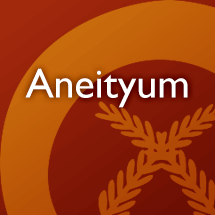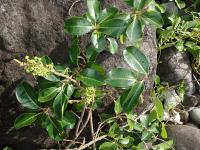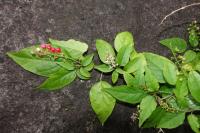Your search for * has returned 100 entries
achachadaliek
adj. tempestuous at sea
bookmarkatcatcaiyu
v. to emit sound from a bottle or coconut
bookmarkategnaijaig pok nelcau
v.n. sail from shore
bookmarkatga nethanethan
v. passed by on the other side
bookmarkdapanan ja jai et lok sto em̃ikope stoi lok
ehlili
v. to burn ground for planting
bookmarkethanethan
adj. at a distance; on the other side of the road.
bookmarkfetofeto
incei u nasuantan

n. subshrub, 0. 5 to 0. 7 m tall (collection: Gregory M. Plunkett #3212)
Example: The common name of this plant means "the plant that belongs to Nasuantan" that being the person who introduced it to Aneityum. He was a person taken from the island as a blackbirder and came back with this plant. It is used for medicine. When a person gets a fresh cut, squeeze the juice from the leaf and put the liquid on the cut to help it heal.
bookmarkinciñpiñti
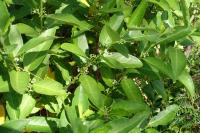
injupjupura
n. night; quite dark
bookmarkinlahlah
n. daylight
bookmarkinligighap
n. the thick end of a coconut leaf used as a target
bookmarkinman anjap
n. sea bird
bookmarkinmathethi
n. Tabernaemontana padacaqui
Example: leaf used for for wounds; cold maceration taken internally against "skin cancer" (severe wounds?). Stalk, chewed, influences sex of an embryo in favor of a girl.
bookmarkinmesese
n. the cold season; winter
bookmarkintesyanyac
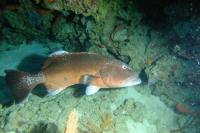
n. Blacksaddled coralgrouper (deep sea)
Example: Photo by jidanchaomian / Flickr, License: CC BY-SA 3.0 via Fishes of Australia
bookmarkintinan nopoi
n. the wicker-work bed (constellation?)
bookmarkitac acen
adj. afar
bookmarkjupmulmul
n. the cool of the evening
bookmarkkaru uwaruwa
n. wind-related term; no definition provided
bookmarklaulau
adj. long, applied to time
bookmarklelen
adj. unripe
bookmarklopot lopot
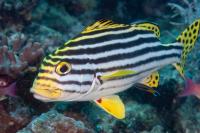
n. Oriental sweetlips
Example: Photo by Mark Rosenstein / iNaturalist.org, License: CC BY-SA 3.0 via Fishes of Australia
bookmarkmaputu-ligighap
n. the stem of a coconut leaf used for a butt
bookmarkmedipmedip
n. kind of breadfruit
bookmarkmurimuri

nagag ~ nacag

nagagnit
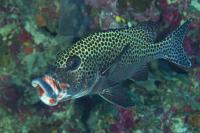
n. Harlequin sweetlips, many-spotted sweetlips
Example: Photo by Mark Rosenstein / iNaturalist.org, License: CC BY-SA 3.0 via Fishes of Australia
bookmarknakweiwei

n. treelet to 1 m, sterile. In transition zone from pine forest to scrub forest. (collection: Michael J. Balick #4981)
Example: The wood is used to make a fishing spear. Cut the straight stems, heat it in fire, straighten it as much as needed, cool the stem, peel the bark off of the stem and let it cure for 1 month. In the past, the end of the spear was carved into a sharp point and used for fishing. Now steel rods are placed on the tip to catch the fish. This is used in shallow water (fresh water or sea water) as the wood is heavy and can sink. People making these spears go to older forests that are higher up to collect the wood.
bookmarknamarere
n. kind of sugarcane
bookmarknamniañia

namotmot
n. grass; also "namutmut"
bookmarknamñiañia

nanad cop̃ou

n. small shrub, 0. 5 m tall (collection: Gregory M. Plunkett #3219)
Example: 1. A stimulant plant. If a person is going to their garden early in the morning before the sun come up, break 2 top young leaves and chew and swallow the liquid, spitting out the fiber. This makes the person able to work harder and not feel tired while in the fields. It was noted that "a person can do the work of many people if they chew this." 2. The leaves are used for fertilizer for taro--put a bunch of leaves in a hole were taro is to be planted as a compost/antibiotic. This practice is said to kill all of the bad organisms such as bacttively impact the health of the taro plant. 3. This species is collected in the coastal areas, and is different from the one that looks similar to it, that grows in the forested areas. People take 4 leaves, chew leaves, swallow juice, gives energy to work hard the entire day. For fishing, take lots of ripe fruits and put in pocket, you will be able to catch a lot of fish. It brings good fortune when fishing. Roots – take one root, wash where a woman is giving birth to a newborn baby, give a drop of the juice from the root to clear the mucus in the throat.
bookmarknanini

napapotan
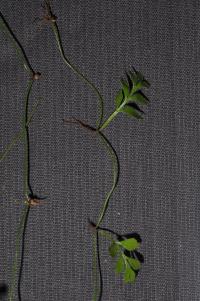
narakiraki
n. a whirlwind
bookmarknarutu arari
n. wind-related term; no definition provided
bookmarknaupiñiña
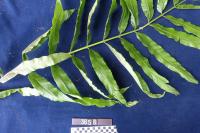
n. terrestrial fern, growing in secondary forest along the river. Leaves c. 2. 25 m long. (collection: Gregory M. Plunkett #3656)
Example: Put several leaves of this species together to wrap food, especially the fresh water eel, and to carry plants of taro, kava, holding the leaves over one’s shoulder to carry these crops.
bookmarknauwau
n. a bulrush; a flag
bookmarknecñanman
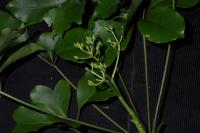
nefelelicai
n. grass; weeds; thistle
bookmarknefelelicai has
n. tares
bookmarknegaivaine
n. a bunch of grapes; also "nigaivaine"
bookmarknejecjec
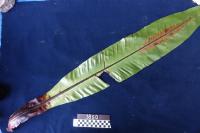
n. epiphyte c. 1 m above forest floor, growing in secondary forest above river. (collection: Gregory M. Plunkett #3650)
Example: The younger,soft leaves are used to wrap local foods, for example bananas. To prepare a type of "local cheese," made from fermented breadfruit and fermented banana, mix a bit of coconut milk and wrap these two fruits in the leaves and cook under ground. Not clear about the way the food is fermented.
bookmarknepjenepjen
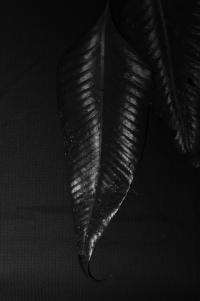
n. epiphytic vine climbing on trees, growing in dense rainforest. (collection: Gregory M. Plunkett #4091)
Example: 1. When a child is between 1 mos. and 1 yr. if the father persists too soon in resuming sexual relations with the mother, the child can become sick. In preparation for the sickness, green leaves are collected. When the sickness occurs, the leaves (now dry) are burned and the baby is washed with the charcoal. 2. After visitors leaves one’s house, one must not hurry to return to their gardens. One waits a few days, then swims with the rachis of this fern tied about their waist. If this practice is not followed, it is believed that the plants in one’s gardens will grow weak.
bookmarknetethae

n. shrub, 1. 5 m tall (collection: Gregory M. Plunkett #3604)
Example: The fruits are edible when ripe--eating them turns the tongue purple. 1. To cure headaches - Someone other than the woman must prepare this. Break the top branch of netethae and remove leaves for use. Combine with the top leaves of the top branch of nelmaha. Chew the leaves and drink the juice. Do this when the sun is setting on the horizon. The woman gives the leftover fibers to the person who prepared the medicine and that person goes and throws the fibers in the direction of the setting sun. 2. Ancestors 4 top branches and chew and spit out remaining fiber will destroy the effects of a love potion that is too strong – meaning that the husband or wife will miss the other person too much so that they become mentally ill. 3. Edible fruits: eating them turns tongue black/purple.
bookmarknirinat erefera ran
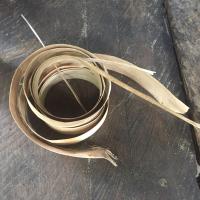
nitit a nelgo waj
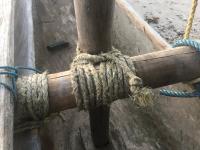
nititan
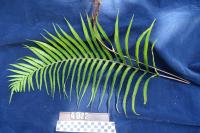
n. fern to 0. 75 m, sori brown. growing along trail. (collection: Michael J. Balick #4972)
Example: The fronds of this fern are used to wrap sting ray and shark meat, which have a great deal of moisture in them, for cooking on the earth overn. Wrap the fronds (leaves) around the meat and tie with a Pandanus string. Because they are not thick, broad, entire leaves, but rather have many places in them where water can drain out during the cooking process, it is said that these leaves are much better for preparing these two types of fish, as well as any other meat that contains a great deal of moisture. For cooking on the earth over, put these wrapped foods on top of any other leaves so that they do not touch the hot stones directly, and then cover with other leaves as well. Then place the hot stones on top of these wrapped meats.
bookmarknititan cei
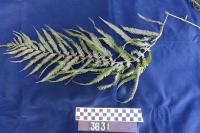
nokoko
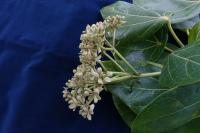
n. large well branched tree, 18-20 m tall (collection: Gregory M. Plunkett #3216)
Example: 1. The trunk of this plant is used to make canoes. 2. It is also a good timber for the inside part of houses. 3. Mix the sap from the stem with other unspecified leaves and rub them into dreadlocks. 4. To attract shells in the sea, scrape a branch and drop in the sea where shells are attracted to the branches and they can be collected for sale to the Island’s visitors. 5. Seeds are used to make beautiful black necklaces. Said to be a lot of work as it is difficult to remove the seed. Rub with sandpaper or soak in water and then make the hole in the seed. 6. Fruit is a children’s toy – used as a whistle to make a nice sound.
bookmarknokoko
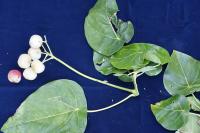
n. tree, 3-4 m tall (collection: Gregory M. Plunkett #3540)
Example: The straight trunk of this tree is used to make canoes. The black seed in the fruit is used to make necklaces. The inner bark is peeled and crushed in sea water and rubbed in the hair to make it curly. People do this treatment every day to make long hair curl like a rasta.
bookmarknomotmot
n. grass
bookmarknomotmot ijis
n. kind of plant, grass, or fern
bookmarknumurumu

rohalrohal
adj. rough, applied to sugarcane-leaf thatch
bookmarksafenunui
n. kind of taro
bookmarktatau

n. Bigeye barracuda
Example: Photo by Philippe Guillaume, License: CC BY-NC 3.0 via Fishes of Australia
bookmarktatau
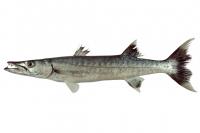
n. Great barracuda
Example: Photo by ANFC, License: CC BY-NC 3.0 via Fishes of Australia
bookmarktatau

n. Pickhandle barracuda
Example: Photo by Mark Rosenstein / iNaturalist.org, License: CC BY-SA 3.0 via Fishes of Australia
bookmarktedtedwaleg
n. kind of plant, grass, or fern
bookmarktehtehen
n. blossom (open)
bookmarkunasuandan
upreupre
n. tough; a kind of coral
bookmarkwudwud
n. kind of tree
bookmark